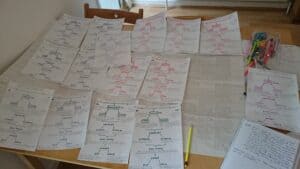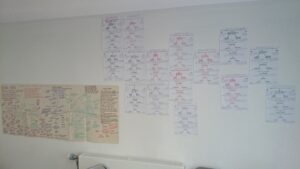I’m now halfway through my Arts Council and Peggy Ramsay Foundation-funded Protected Time to Write project. This is blog 5 in a series of 10 tracking a playwright’s process from initial ideas to first draft, in a bid to share some of the learning that’s coming out of it.
You can click on the links here for Blog 1, Blog 2, Blog 3 and Blog 4.
Blog 5 first appeared on Lane’s List on June 1st 2015.
‘So, what’s your play about then?’
It’d been four and a half weeks since I’d even thought about it. A generation-defining election had come and gone. A small baby had arrived in my life. The last thing I’d done on the project in April, before paternity, was to celebrate with my dramaturg how the ideas were strong but perhaps that I had too many of them, and in particular two protagonists fighting for attention.
Big choices ahead. But no matter. I would happily leave it to ‘settle and percolate’ – a part of the process that had always been built into the project, where I could absolve myself of battling with the ideas, get on with being a new Dad again and, meanwhile, the answers would LIKE SOME KIND OF NON-THINKING PLAYWRITING MAGIC simply arrive pre-selected and beautiful in my brain.
This would all happen whilst I was, I dunno, changing a nappy or building a sandpit or putting the recycling out or something.
‘So, what’s your play about then?’
‘It’s about the stories we tell ourselves to survive. And it’s about a nation that’s been told the same story about itself for so long, that it’s almost forgotten there used to be another one. It’s about how human beings use their creativity to maintain their versions of the truth in the face of extreme emotional and political crisis. It’s about losing a child, losing a nation and losing faith. It’s about how far you might go – how unjust you might have to be – to achieve justice.’
I felt pretty pleased with myself after that. Admittedly there was a bit of err umm ahh umm kinda sort of in there originally, but this is the gist.
‘Great. So what happens in the story?’
Bugger.
The Trusting Yourself part of this blog title is about two things for me.
Firstly, it’s about trusting that what comes out of your mouth when your head’s in a completely different space from your writing will reflect what it’s really about for you. Some of you might get that when washing up, or walking the dog, or doing something totally unrelated to the writing of a play. I got it whilst entertaining five toddlers and two babies at our house with my wife and a selection of other non-theatre-related parenting friends.
Secondly, it’s about trusting that your brain really is being receptive to what’s around you in the real world. The ‘your’ bit of ‘your writing’ is about ‘you’. Yes, the play was always about losing a child right from the beginning, but since then it had become a behemoth that required me to create fifteen characters and an entire fictional Middle Eastern state with its own 5,000 year-old creation myth.
Then the election happened, fatherhood re-happened (the crazy early bit at least) and I knew that the exact focus of this play would be different to how I’d imagined it before these two events.
Be it the rest, the space, the luxury of a funded four weeks already spent planning and thinking – but the writing bit of me and the me bit of me had been silently plotting, getting on with that percolation I hoped might happen behind the scenes.
Suddenly the play seemed to be working out its focus in relation to what I was responding to right now in my own life, my own world – and hopefully, the audience’s world as a result. The overall architecture and broad brushstrokes hadn’t changed; but the emphasis, or accent, in this fictional creation had adjusted itself without me noticing.
IT WAS PLAYWRITING MAGIC.
Well, actually, no it wasn’t.
It had always been about nations and stories, but now it was about a nation utterly bewildered by the story it had ended up in and wondering what the hell it was going to do about it (see: Tory majority). It was always about parenthood, but now it was about how you connect the political context with an innocent child’s future (see: new baby).
Which brings me to the second part of this blog title, which is the Trusting the Process bit.
I was a bit harsh on process last time we met. I actually accused it of paralysing me, which was a bit strong. What actually happened was that there was far less free-thinking going on: the bit that requires you to make lots of bad choices, get lost, not know where you’re heading, career around a bit. I’d manoeuvred myself into a corner where I had to KNOW rather than FIND OUT.
Some of you writers will begin with writing. Proper scriptwriting scene-writing dialogue-writing all-the-story-at-first-sitting writing. There was a bit of me that used to do that too, but now it’s flipped over and I need to have a big pool of knowledge to work from first so I can make better, stronger, more informed dramaturgical choices in terms of the world of the play – which by that point will be as fully-rendered as it can be without, y’know, actually setting up a new Middle Eastern state myself (I tried, but the Arts Council won’t fund work of expressly political intent).
What I learned this week was that I was trying to know too much to the point of total fear. Worse, I was trying to convince myself I was free-thinking when actually I was still doing process.
For example, all the A4 character sheets you can see on the photo above are about nailing some specifics for each of them: key positive and negative traits; value systems; needs and wants now, in a year, before they die; internal/external obstacles to this; first action in play to get over that.
Let’s clear up the context – I had to write a treatment this week. The whole story of the whole play in prose form, from which I could then write a first draft. So, I felt like I needed to know that stuff above.
I was struggling with the treatment writing when a director friend recommended firstly, to stop trying to write 15 massively complete complex character arcs in one play, and let the ones that needed to sing, sing; and secondly, to write 3 x 20-minute versions of it. Great idea, borrowed from the devising room floor. Sit down for 20 minutes and bash out the whole story in bullet-point, scrappy, rough form to see what comes up. Three times.
I really really tried to do this, but each time I stopped myself. That character wouldn’t do that. This character wouldn’t do this. This doesn’t make sense. But how does the story get from there to there… let me just check back through my notes and planning and research… um… oh look an hour has passed and I’ve written ONE PARAGRAPH.
So I crashed on with the A4 sheets until they were all done. It was still helpful. But still no treatment, halfway through the week.
Back at theatre HQ I decided to arrange all these characters on the wall, so I could see them together. I began by just grouping them into family / theme, then I remembered that conversation at my house:
‘Great. So what happens in the story?’
I carried on but gave myself a rule: to arrange them on the basis of the most important relationship connections in the play: the points of most conflict and tension. That took an hour, but it was story-writing without realising it. Suddenly, the plot began to suggest itself simply through the proximity of the characters and having to make a choice about which duos and trios best sparked off together.
Free-thinking and process now seemed to be on a successful first date.
I went back to the exercise from my director friend. This time, the first few scenes plopped out. Admittedly they were begging to be done in detail, so I threw the clock timer out of the scenario and indulged a good couple of hours really thinking them through.
Oh. Look! I’d started writing the treatment.
AS IF BY PLAYWRITING MAG –
No. This is when I realised I should always have been trusting the process. Synapses suddenly began to fire, but across the whole time and space of the entire ideas journey – even back to November when I aborted writing and cracked on with my funding applications.
Things I’d forgotten from the research weeks suddenly concretised into character action, backstory, the nation’s mythological fabric, the deadline for the story. Tiny anecdotes among pages and pages of reading translated into plot points, without me even having to look back at them. The whirlwind of creative forward-movement in terms of story and action was being fed by the process, and I was feeling GOOD about my choices. They were intricate, complex, and they were exciting me. They were difficult for the characters, which would mean harder and more challenging writing.
I’m now sitting on another day’s work, and I can sit down and write the script. But I’m doing it without any fear. I know this world. I know what pins it together. I know ENOUGH. There’s loads I don’t know, but I trust fully now that the best possible answers will present themselves for this stage in the journey. It’s only a first go.
Bring it.


